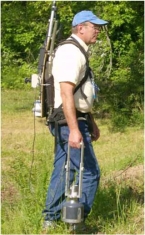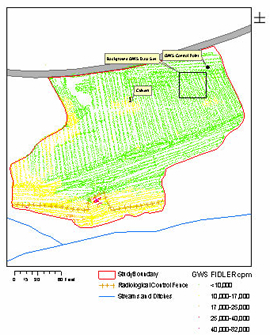Green Remediation Focus
Paducah Gaseous Diffusion Plant
Paducah, Kentucky
Federal Facility, Superfund NPL
Cleanup Objectives: Characterize and remediate soil contaminated with uranium and polychlorinated biphenyls (PCBs) at the site's area of concern (AOC) 492
Green Remediation Strategy:
- Used the Triad approach to integrate site characterization, remedial activities, and cleanup verification in a 7,000 foot2 area with suspected uranium and PCB contamination
- Convened federal and state agencies to develop a conceptual site model and dynamic work plan prior to beginning any field work
- Used investigative tools requiring no soil disturbance, including laser-based gamma "walkover" surveys (GWS) and x-ray fluorescence (XRF) with in situ gamma spectroscopy (ISGS)
- Used field techniques involving few analytical samples and minimal sampling waste, including PCB immunoassay kits, multi-increment sampling, and adaptive compositing
- Relied on real-time data for decisionmaking in the field
Results:
- Integrated field information involving 24,000 GWS data points, hundreds of XRF measurements, and nearly 400 surface soil increments, which resulted in a need for laboratory confirmation on only 23 samples instead of an estimated 300 samples involved in a traditional field approach
- Minimized generation of sampling waste through use of state-of-the-art tools and dynamic work planning
- Surgically excavated 13 meter3 of uranium-contaminated soil comprising the contaminant "hotspot", and disposed the material at an off-site facility
- Completed investigatory, removal, and verification activities in a single 10-day field mobilization, resulting in less dust generation, fuel consumption, and site disturbance
- Saved significant time and costs in reaching cleanup closure when compared to traditional, static work plans involving multiple field mobilizations, reiterative activities, and significantly more sample analysis performed by an offsite, fixed laboratory
Property End Use: Ongoing uranium enrichment activities conducted by the U.S. Department of Energy (DOE)
Point of Contact: Rich Bonczek, DOE Portsmouth/Paducah Project Office







